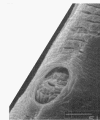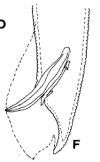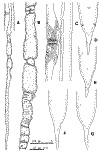|
Female:
Median bulb
well-developed.
Excretory pore level with center of median bulb.
Basal esophageal bulb elongate-pyriform. Not overlapping
to slight ventral overlap of intestine.
Vulva a transverse slit in an oval depression which
has anterior and posterior pouches that appear to be sclerotized.
Cuticle on ventral surface anterior and posterior to vulva with up to
10 deep grooves
separated by two or three annules. (miradvulvus =
unusual near vulva).
 
Interior of vagina with strengthening ridges.
Ovaries paired, outstretched, spermathecae present.
Tail tapering abruptly then conoid.
Male: Similar to female.
Spicules
and gubernaculum slightly arcuate. Gubernaculum with reflexed distal
tip.

Males have unique caudal alae,
well-developed. Tail tip not bifurcate.
|

Dolichodorus miradvulvus A) Female gonad. B)
Spermatheca C) Vulval region with grooves and pouches anterior and
posterior to vulva, strengthening ridges in the vagina and muscles
attached to the vaginal wall and body wall. D) Female tail, ventral
view. E) Female tail, lateral view. F) Juvenile tail
withgradual
tapering. G) Juvenile tail with abrupt tapering.
Drawings
and photographs from Smart and Khoung, 1985 |